Bagging a Greener Future: Social Norms Appeals and Financial Incentives in Promoting Reusable Bags Among Grocery Shoppers
Abstract
1. Introduction
1.1. Social Norms Appeals and Pro-Environmental Behaviors
1.1.1. Static Descriptive and Injunctive Norms
1.1.2. Dynamic Descriptive and Injunctive Norms
1.2. Financial Incentives and Pro-Environmental Behaviors
1.3. Social Norm Appeals and Financial Incentives
2. Materials and Methods
2.1. Participants
2.2. Research Design and Procedures
2.3. Message Stimuli
2.4. Measures
3. Results
3.1. Random Assignment and Identification of Covariates
3.2. Test the Hypotheses and Answer Research Questions (RQs)
4. Discussion
4.1. Implications
4.2. Limitations and Future Research
5. Conclusions
Author Contributions
Funding
Institutional Review Board Statement
Informed Consent Statement
Data Availability Statement
Conflicts of Interest
Appendix A. Map of the Data Collection Locations
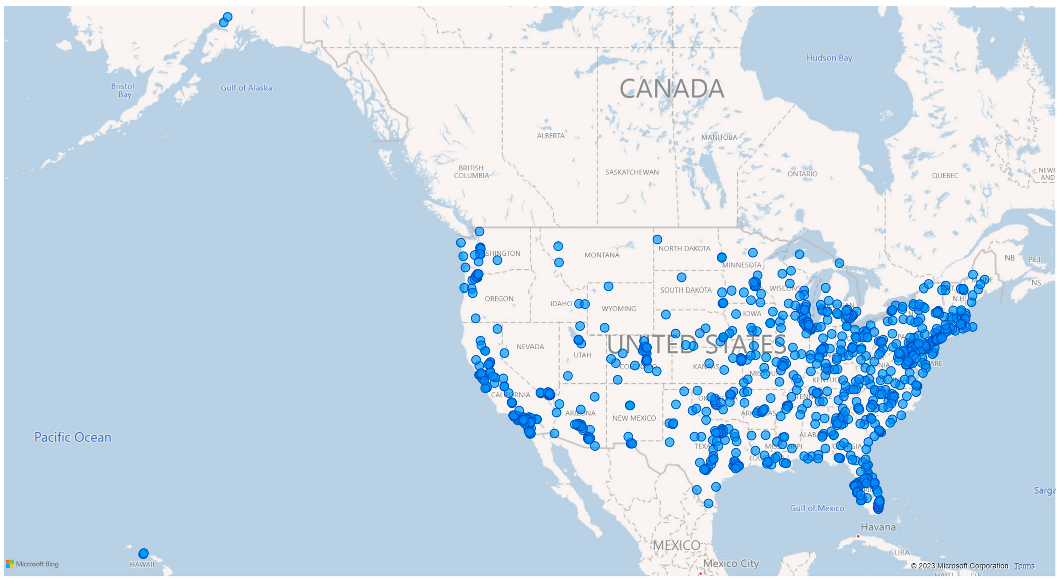
Appendix B. Screenshots of the Video Used in the Experiment
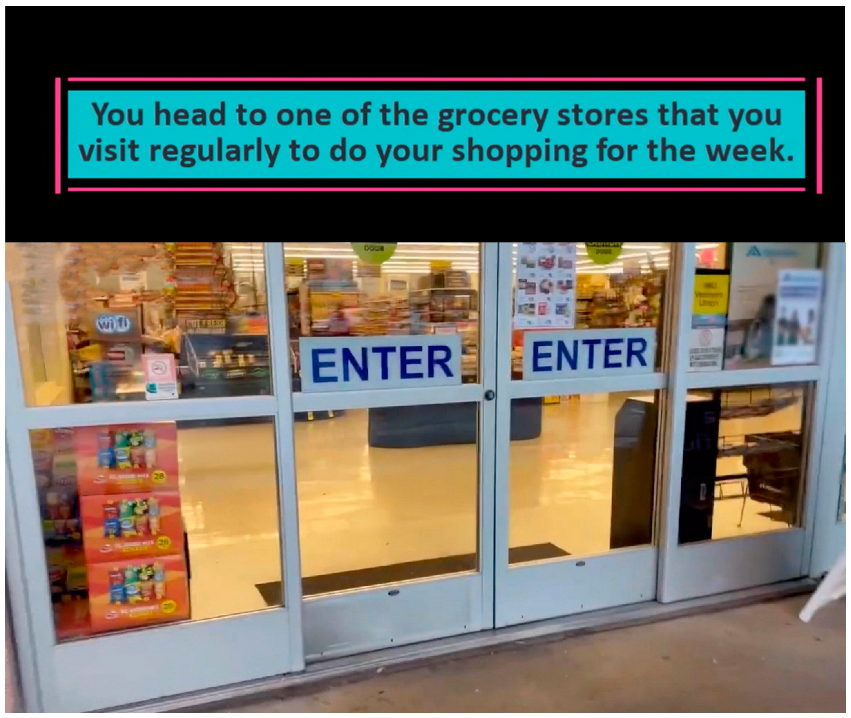
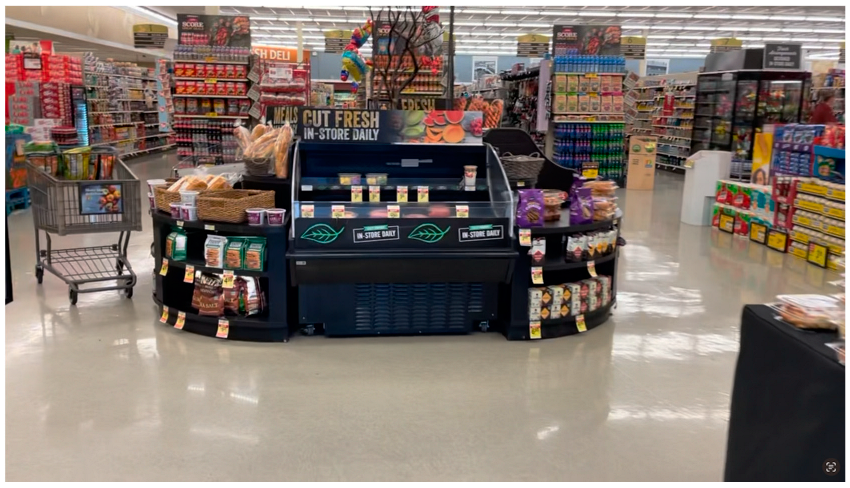
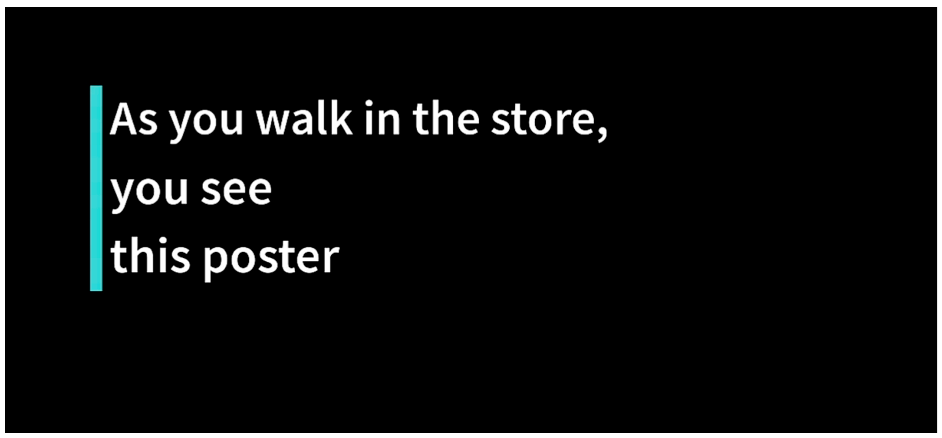
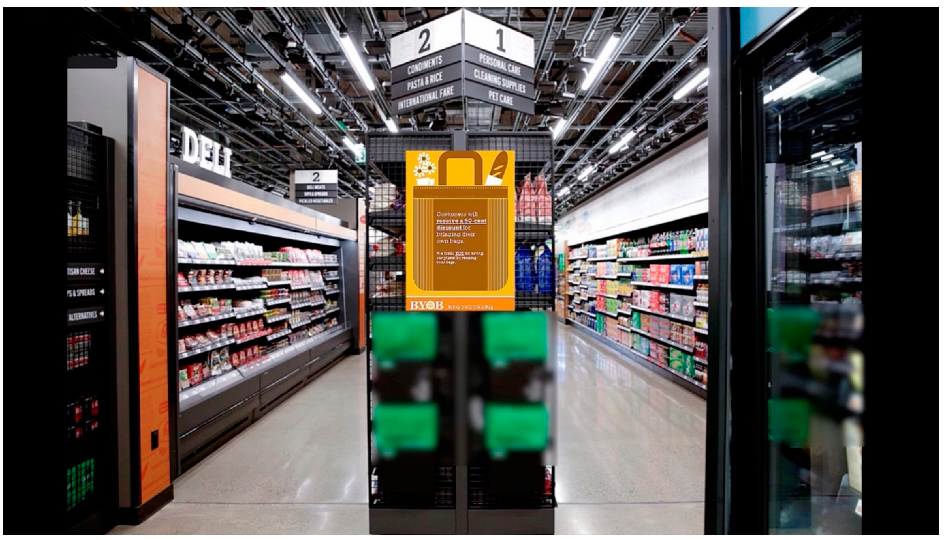
Appendix C. Message Stimuli

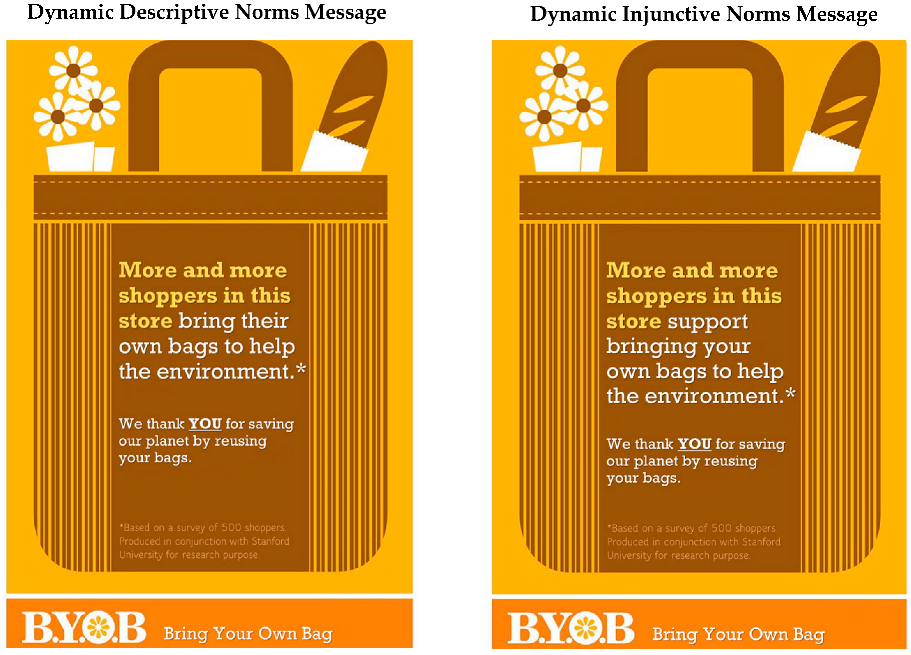
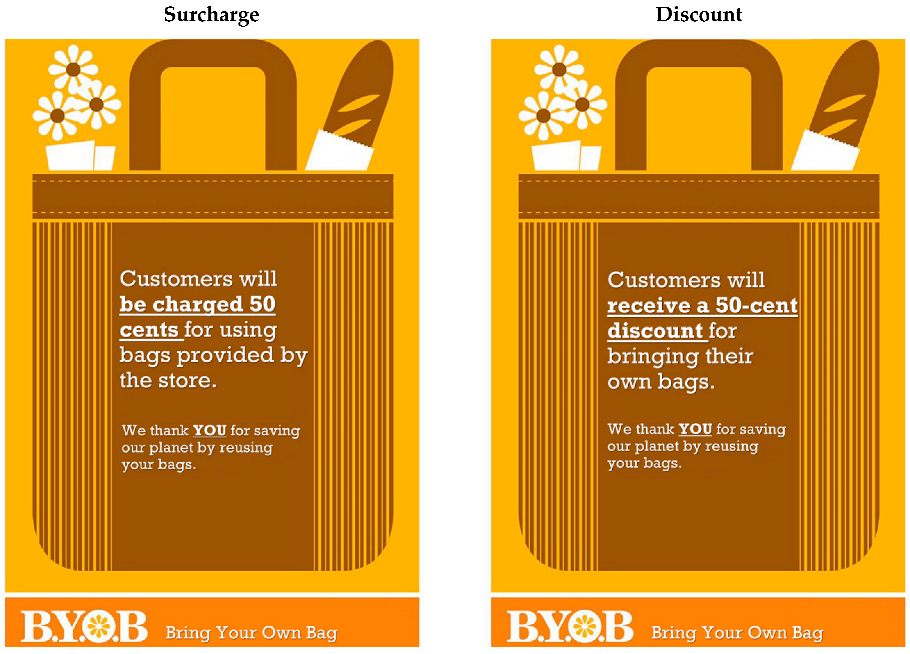
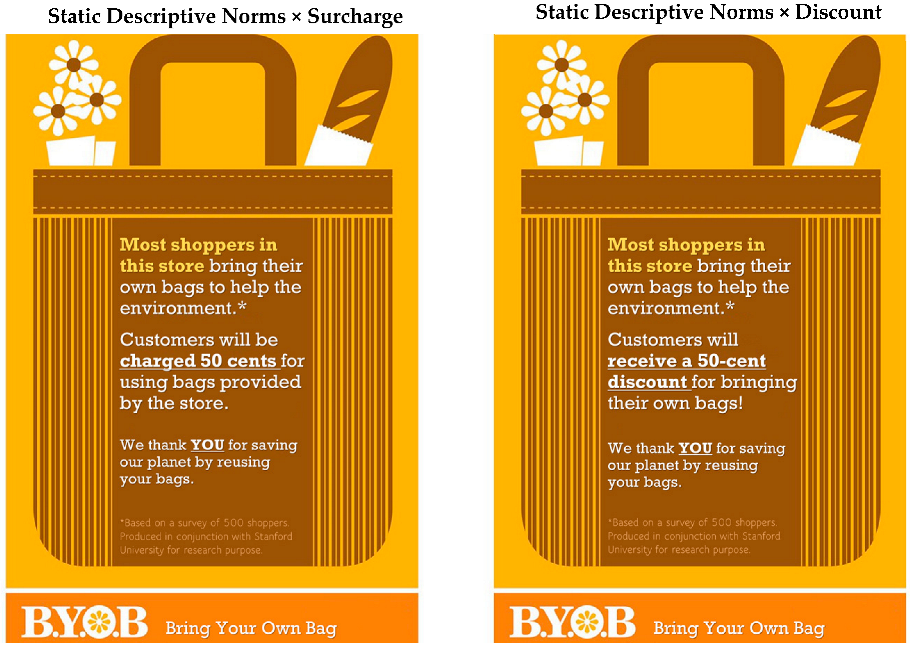
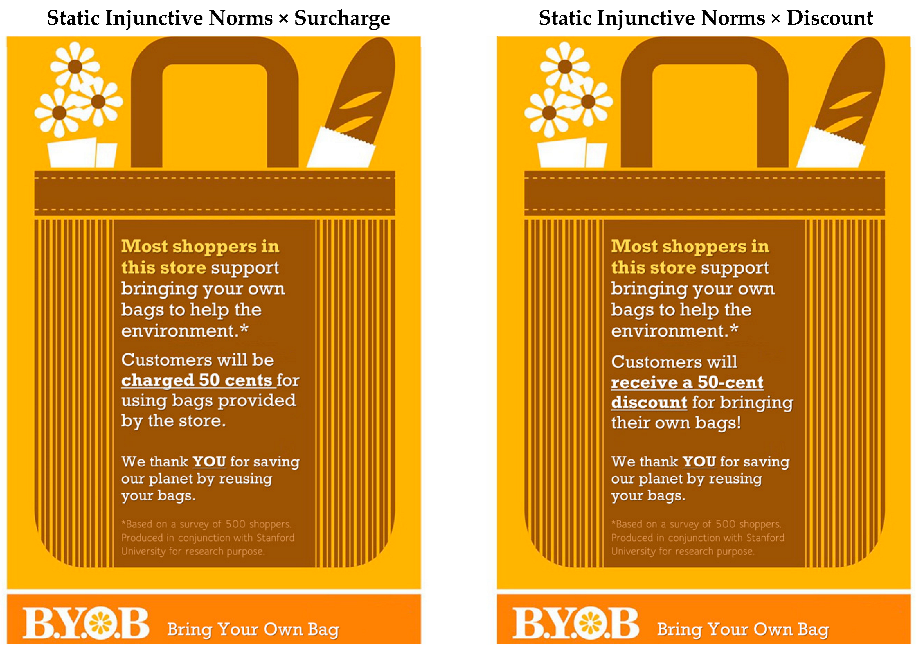
Appendix D. Results of Regression Analysis for Identifying Covariates
| 95.0% Confidence Interval for B | |||||||
| Unstandardized B | Standard Error | Standardized β | t | p | Lower Bound | Upper Bound | |
| (Intercept) | 0.06 | 0.47 | 0.13 | 0.90 | −0.86 | 0.99 | |
| Age | 0.01 | 0.00 | 0.08 | 2.18 | 0.03 | 0.00 | 0.01 |
| Gender | 0.04 | 0.07 | 0.02 | 0.67 | 0.51 | −0.09 | 0.17 |
| Education | −0.03 | 0.02 | −0.03 | −1.07 | 0.29 | −0.07 | 0.02 |
| White (1) | 0.02 | 0.14 | 0.01 | 0.18 | 0.86 | −0.25 | 0.29 |
| Black (1) | −0.11 | 0.17 | −0.03 | −0.61 | 0.55 | −0.45 | 0.24 |
| Household Size | 0.00 | 0.03 | 0.00 | −0.09 | 0.93 | −0.05 | 0.05 |
| Income | 0.01 | 0.02 | 0.01 | 0.32 | 0.75 | −0.03 | 0.05 |
| Single (1) | 0.01 | 0.23 | 0.01 | 0.05 | 0.96 | −0.44 | 0.46 |
| Married (1) | 0.04 | 0.22 | 0.02 | 0.17 | 0.86 | −0.40 | 0.48 |
| Separated/Divorced/Widowed (1) | −0.08 | 0.23 | −0.03 | −0.33 | 0.74 | −0.53 | 0.37 |
| Religious (1) | 0.12 | 0.07 | 0.06 | 1.87 | 0.06 | −0.01 | 0.25 |
| Republican | 0.26 | 0.25 | 0.11 | 1.03 | 0.30 | −0.23 | 0.75 |
| Democrat | 0.30 | 0.25 | 0.13 | 1.18 | 0.24 | −0.20 | 0.80 |
| Independent | 0.29 | 0.25 | 0.12 | 1.16 | 0.25 | −0.20 | 0.78 |
| Liberal-Conservative | 0.00 | 0.01 | −0.02 | −0.46 | 0.65 | −0.01 | 0.01 |
| Prior Plastic Bags Usage | 0.00 | 0.00 | −0.03 | −0.61 | 0.54 | −0.00 | 0.00 |
| Prior Reusable Bags Usage | 0.00 | 0.00 | 0.13 | 3.17 | 0.00 | 0.00 | 0.01 |
| Weekly Shop Trip | −0.02 | 0.02 | −0.03 | −0.91 | 0.36 | −0.05 | 0.02 |
| Shop Responsibility | −0.08 | 0.06 | −0.04 | −1.35 | 0.18 | −0.20 | 0.04 |
| Shop Mode | −0.01 | 0.08 | 0.00 | −0.14 | 0.89 | −0.17 | 0.14 |
| Environmental Concerns | 0.14 | 0.04 | 0.12 | 3.40 | <0.001 | 0.06 | 0.22 |
| Attitudes | 0.65 | 0.05 | 0.53 | 13.70 | <0.001 | 0.56 | 0.74 |
| adjusted R2 = 0.45, F(22, 696) = 27.24, p < 0. 001 | |||||||
References
- United Nations Environment Programme. Single-Use Plastics: A Roadmap for Sustainability; UNEP—UN Environment Programme: Nairobi, Kenya, 2018. [Google Scholar]
- United Nations Environment Programme. NEGLECTED: Environmental Justice Impacts of Marine Litter and Plastic Pollution; UNEP—UN Environment Programme: Nairobi, Kenya, 2021. [Google Scholar]
- Khoaele, K.K.; Gbadeyan, O.J.; Chunilall, V.; Sithole, B. The devastation of waste plastic on the environmental and remediation processes: A critical review. Sustainability 2023, 15, 5233. [Google Scholar] [CrossRef]
- Suleman, R.; Amjad, A.; Ismail, A.; Javed, S.; Ghafoor, U.; Fahad, S. Impact of plastic bags usage in food commodities: An irreversible loss to environment. Environ. Sci. Pollut. Res. 2022, 29, 49483–49489. [Google Scholar] [CrossRef] [PubMed]
- Chung, M.; Lapinski, M.K. The effect of dynamic norms messages and group identity on pro-environmental behaviors. Commun. Res. 2024, 51, 439–462. [Google Scholar] [CrossRef]
- Heidbreder, L.M.; Bablok, I.; Drews, S.; Menzel, C. Tackling the plastic problem: A review on perceptions, behaviors, and interventions. Sci. Total Environ. 2019, 668, 1077–1093. [Google Scholar] [CrossRef] [PubMed]
- Jakovcevic, A.; Steg, L.; Mazzeo, N.; Caballero, R.; Franco, P.; Putrino, N.; Favara, J. Charges for plastic bags: Motivational and behavioral effects. J. Environ. Psychol. 2014, 40, 372–380. [Google Scholar] [CrossRef]
- Deci, E.L.; Koestner, R.; Ryan, R.M. A meta-analytic review of experiments examining the effects of extrinsic rewards on intrinsic motivation. Psychol. Bull. 1999, 125, 627–668. [Google Scholar] [CrossRef]
- Cialdini, R.B.; Trost, M.R. Social influence: Social norms, conformity and compliance. In The Handbook of Social Psychology, 4th ed.; McGraw-Hill: New York, NY, USA, 1998; Volume 1–2, pp. 151–192. [Google Scholar]
- Lapinski, M.K.; Kerr, J.M.; Zhao, J.; Shupp, R.S. Social norms, behavioral payment programs, and cooperative behaviors: Toward a theory of financial incentives in normative systems. Hum. Commun. Res. 2017, 43, 148–171. [Google Scholar] [CrossRef]
- Sparkman, G.; Walton, G.M. Dynamic norms promote sustainable behavior, even if it is counternormative. Psychol. Sci. 2017, 28, 1663–1674. [Google Scholar] [CrossRef]
- Cialdini, R.B.; Reno, R.R.; Kallgren, C.A. A focus theory of normative conduct: Recycling the concept of norms to reduce littering in public places. J. Personal. Soc. Psychol. 1990, 58, 1015–1026. [Google Scholar] [CrossRef]
- De Groot, J.I.M.; Bondy, K.; Schuitema, G. Listen to others or yourself? The role of personal norms on the effectiveness of social norm interventions to change pro-environmental behavior. J. Environ. Psychol. 2021, 78, 101688. [Google Scholar] [CrossRef]
- Sparkman, G.; Howe, L.; Walton, G. How social norms are often a barrier to addressing climate change but can be part of the solution. Behav. Public Policy 2021, 5, 528–555. [Google Scholar] [CrossRef]
- Amel, E.; Manning, C.; Scott, B.; Koger, S. Beyond the roots of human inaction: Fostering collective effort toward ecosystem conservation. Science 2017, 356, 275–279. [Google Scholar] [CrossRef]
- De Groot, J.I.M.; Abrahamse, W.; Jones, K. Persuasive normative messages: The influence of injunctive and personal norms on using free plastic bags. Sustainability 2013, 5, 1829–1844. [Google Scholar] [CrossRef]
- Park, S.-Y. The moderating role of descriptive norms on construal-level fit: An examination in the context of “less plastic” campaigns. Environ. Commun. 2021, 15, 235–249. [Google Scholar] [CrossRef]
- Dorigoni, A.; Bonini, N. Water bottles or tap water? A descriptive-social-norm based intervention to increase a pro-environmental behavior in a restaurant. J. Environ. Psychol. 2023, 86, 101971. [Google Scholar] [CrossRef]
- Borg, K.; Curtis, J.; Lindsay, J. Social norms and plastic avoidance: Testing the theory of normative social behaviour on an environmental behaviour. J. Consum. Behav. 2020, 19, 594–607. [Google Scholar] [CrossRef]
- Mertens, S.; Herberz, M.; Hahnel, U.J.J.; Brosch, T. The effectiveness of nudging: A meta-analysis of choice architecture interventions across behavioral domains. Proc. Natl. Acad. Sci. USA 2022, 119, e2107346118. [Google Scholar] [CrossRef]
- Bastini, K.; Kerschreiter, R.; Lachmann, M.; Ziegler, M.; Sawert, T. Encouraging individual contributions to net-zero organizations: Effects of behavioral policy interventions and social norms. J. Bus. Ethics 2024, 192, 543–560. [Google Scholar] [CrossRef]
- Savari, M.; Damaneh, H.E.; Damaneh, H.E.; Cotton, M. Integrating the norm activation model and theory of planned behaviour to investigate farmer pro-environmental behavioural intention. Sci. Rep. 2023, 13, 5584. [Google Scholar] [CrossRef]
- Nolan, J.M. Social norm interventions as a tool for pro-climate change. Curr. Opin. Psychol. 2021, 42, 120–125. [Google Scholar] [CrossRef]
- Benedict, S.; Hussein, H. An analysis of water awareness campaign messaging in the case of Jordan: Water conservation for state security. Water 2019, 11, 1156. [Google Scholar] [CrossRef]
- Rimal, R.N.; Lapinski, M.K. A re-explication of social norms, ten years later. Commun. Theory 2015, 25, 393–409. [Google Scholar] [CrossRef]
- Sparkman, G.; Walton, G.M. Witnessing change: Dynamic norms help resolve diverse barriers to personal change. J. Exp. Soc. Psychol. 2019, 82, 238–252. [Google Scholar] [CrossRef]
- Carfora, V.; Zeiske, N.; van der Werff, E.; Steg, L.; Catellani, P. Adding dynamic norm to environmental information in messages promoting the reduction of meat consumption. Environ. Commun. 2022, 16, 900–919. [Google Scholar] [CrossRef]
- Lee, S.J.; Liu, J. Leveraging dynamic norm messages to promote counter-normative health behaviors: The moderating role of current and future injunctive norms, attitude and self-efficacy. Health Commun. 2023, 38, 1071–1079. [Google Scholar] [CrossRef]
- Hall, P.A.; Fong, G.T.; Hitchman, S.C.; Quah, A.C.K.; Agar, T.; Meng, G.; Ayaz, H.; Dore, B.P.; Sakib, M.N.; Hudson, A.; et al. Brain and behavior in health communication: The Canadian COVID-19 Experiences Project. Brain Behav. Immun. Health 2022, 22, 100467. [Google Scholar] [CrossRef]
- Lieberman, A.; Duke, K.E.; Amir, O. How incentive framing can harness the power of social norms. Organ. Behav. Hum. Decis. Process. 2019, 151, 118–131. [Google Scholar] [CrossRef]
- Wagner, T.P. Reducing single-use plastic shopping bags in the USA. Waste Manag. 2017, 70, 3–12. [Google Scholar] [CrossRef]
- National Conference of State Legislatures. State Plastic and Paper Bag Legislation; National Conference of State Legislatures: Denver, CO, USA, 2019. [Google Scholar]
- Nielsen, T.D.; Holmberg, K.; Stripple, J. Need a bag? A review of public policies on plastic carrier bags—Where, how and to what effect? Waste Manag. 2019, 87, 428–440. [Google Scholar] [CrossRef]
- Poortinga, W.; Whitmarsh, L.; Suffolk, C. The introduction of a single-use carrier bag charge in Wales: Attitude change and behavioural spillover effects. J. Environ. Psychol. 2013, 36, 240–247. [Google Scholar] [CrossRef]
- Thomas, G.O.; Poortinga, W.; Sautkina, E. The Welsh single-use carrier bag charge and behavioural spillover. J. Environ. Psychol. 2016, 47, 126–135. [Google Scholar] [CrossRef]
- Homonoff, T.A. Can small incentives have large effects? The impact of taxes versus bonuses on disposable bag use. Am. Econ. J. Econ. Policy 2018, 10, 177–210. [Google Scholar] [CrossRef]
- Abiola, B.A.; Visser, M.; Daniels, R.C. Addressing plastic bags consumption crises through store monetary and non-monetary interventions in South Africa. Front. Sustain. 2023, 3, 968886. [Google Scholar] [CrossRef]
- Wang, B.; Zhao, Y.; Li, Y. How do tougher plastics ban policies modify people’s usage of plastic bags? A case study in China. Int. J. Environ. Res. Public Health 2021, 18, 10718. [Google Scholar] [CrossRef] [PubMed]
- Pellerano, J.A.; Price, M.K.; Puller, S.L.; Sánchez, G.E. Do extrinsic incentives undermine social norms? Evidence from a field experiment in energy conservation. Environ. Resour. Econ. 2017, 67, 413–428. [Google Scholar] [CrossRef]
- Kerr, J.M.; Lapinski, M.K.; Liu, R.W.; Zhao, J. Long-term effects of payments for environmental services: Combining insights from communication and economics. Sustainability 2017, 9, 1627. [Google Scholar] [CrossRef]
- United States Census Bureau. U.S. Census Bureau QuickFacts: United States; United States Census Bureau: Suitland-Silver Hill, MD, USA, 2022. [Google Scholar]
- Kang, H. Sample size determination and power analysis using the G*Power software. J. Educ. Eval. Health Prof. 2021, 18, 17. [Google Scholar] [CrossRef]
- Rhodes, N.; Shulman, H.C.; McClaran, N. Changing norms: A meta-analytic integration of research on social norms appeals. Hum. Commun. Res. 2020, 46, 161–191. [Google Scholar] [CrossRef]
- Farrow, K.; Grolleau, G.; Ibanez, L. Social norms and pro-environmental behavior: A review of the evidence. Ecol. Econ. 2017, 140, 1–13. [Google Scholar] [CrossRef]
- National Social Norms Center. Social Norms Approach; National Social Norms Center: East Lansing, MI, USA, 2022. [Google Scholar]
- O’Keefe, D.J. Message properties, mediating states, and manipulation checks: Claims, evidence, and data analysis in experimental persuasive message effects research. Commun. Theory 2003, 13, 251–274. [Google Scholar] [CrossRef]
- Choudaha, R. Americans’ Most Trusted Universities, and the Need to Bridge Gaps in Public Trust; Morning Consult: Washington, DC, USA, 2022. [Google Scholar]
- Lapinski, M.K.; Rimal, R.N.; DeVries, R.; Lee, E.L. The role of group orientation and descriptive norms on water conservation attitudes and behaviors. Health Commun. 2007, 22, 133–142. [Google Scholar] [CrossRef] [PubMed]
- Schultz, P.W. The structure of environmental concern: Concern for self, other people, and the biosphere. J. Environ. Psychol. 2001, 21, 327–339. [Google Scholar] [CrossRef]
- Steg, L.; Bolderdijk, J.W.; Keizer, K.; Perlaviciute, G. An integrated framework for encouraging pro-environmental behaviour: The role of values, situational factors and goals. J. Environ. Psychol. 2014, 38, 104–115. [Google Scholar] [CrossRef]
- Jacobson, R.P.; Mortensen, C.R.; Cialdini, R.B. Bodies obliged and unbound: Differentiated response tendencies for injunctive and descriptive social norms. J. Personal. Soc. Psychol. 2011, 100, 433–448. [Google Scholar] [CrossRef] [PubMed]
- Guagnano, G.A.; Stern, P.C.; Dietz, T. Influences on attitude-behavior relationships: A natural experiment with curbside recycling. Environ. Behav. 1995, 27, 699–718. [Google Scholar] [CrossRef]
- Yoeli, E.; Hoffman, M.; Rand, D.G.; Nowak, M.A. Powering up with indirect reciprocity in a large-scale field experiment. Proc. Natl. Acad. Sci. USA 2013, 110, 10424–10429. [Google Scholar] [CrossRef]
- Kronrod, A.; Grinstein, A.; Wathieu, L. Go green! Should environmental messages be so assertive. J. Mark. 2012, 76, 95–102. [Google Scholar] [CrossRef]
- Abrahamse, W.; Steg, L. Social influence approaches to encourage resource conservation: A meta-analysis. Glob. Environ. Chang. 2013, 23, 1773–1785. [Google Scholar] [CrossRef]
- Nisa, C.F.; Bélanger, J.J.; Schumpe, B.M.; Faller, D.G. Meta-analysis of randomised controlled trials testing behavioural interventions to promote household action on climate change. Nat. Commun. 2019, 10, 4545. [Google Scholar] [CrossRef]
- Lokhorst, A.M.; Werner, C.; Staats, H.; van Dijk, E.; Gale, J.L. Commitment and behavior change: A meta-analysis and critical review of commitment-making strategies in environmental research. Environ. Behav. 2013, 45, 3–34. [Google Scholar] [CrossRef]
- Nomura, H.; John, P.C.; Cotterill, S. The use of feedback to enhance environmental outcomes: A randomized controlled trial of a food waste scheme. Local Environ. 2011, 16, 637–653. [Google Scholar] [CrossRef]
- Schorn, A. Why should I when no one else does? A review of social norm appeals to promote sustainable minority behavior. Front. Psychol. 2024, 15, 1415529. [Google Scholar] [CrossRef] [PubMed]
- Melnyk, V.; Carrillat, F.A.; Melnyk, V. The influence of social norms on consumer behavior: A meta-analysis. J. Mark. 2022, 86, 98–120. [Google Scholar] [CrossRef]
- Melnyk, V.; Herpen Evan Fischer, A.R.H.; van Trijp, H.C.M. To think or not to think: The effect of cognitive deliberation on the influence of injunctive versus descriptive social norms. Psychol. Mark. 2011, 28, 709–729. [Google Scholar] [CrossRef]
- Schubert, C. Green nudges: Do they work? Are they ethical? Ecol. Econ. 2017, 132, 329–342. [Google Scholar] [CrossRef]
- Smith, J.R.; Louis, W.R.; Terry, D.J.; Greenaway, K.H.; Clarke, M.R.; Cheng, X. Congruent or conflicted? The impact of injunctive and descriptive norms on environmental intentions. J. Environ. Psychol. 2012, 32, 353–361. [Google Scholar] [CrossRef]
| Percentage | Mean (SD) | |
|---|---|---|
| Race/Ethnicity (2022 U.S. Census Data) | ||
| Asian/Asian American | 6.8 (6.3) | |
| Black or African American | 14.4 (13.6) | |
| Native American or Alaskan Natives | 0.4 (1.3) | |
| Pacific Islander/Native Hawaiian | 0.2 (0.3) | |
| White | 74.5 (75.5) | |
| Bi- or Multiracial | 2.8 (3) | |
| Other/Prefer not to answer | 0.9 | |
| Hispanic or Latino (collected separately from racial identity) | 17.9 (19.1) | |
| Marital Status | ||
| Single (never married) | 32.8 | |
| Married | 43.1 | |
| Separated | 1.7 | |
| Divorced | 13.5 | |
| Widowed | 6.5 | |
| In a relationship/cohabitation | 0.4 | |
| Other/Prefer not to answer | 2.1 | |
| Education | ||
| Less than high school | 2.4 | |
| High school graduate | 21.5 | |
| 2-year associate degree | 11.9 | |
| Some college (without receiving a degree or diploma) | 22.6 | |
| 4-year college degree | 25.1 | |
| Master or professional degree | 12.6 | |
| Doctorate | 2.8 | |
| Other | 1 | |
| Household Income | ||
| Less than USD 25,000 | 24 | |
| USD 25,000 to USD 34,999 | 15.8 | |
| USD 35,000 to USD 49,999 | 16 | |
| USD 50,000 to USD 74,999 | 16.3 | |
| USD 75,000 to USD 99,999 | 11.9 | |
| USD 100,000 to USD 149,999 | 9.4 | |
| USD 150,000 to USD 199,999 | 4.4 | |
| USD 200,000 or more | 2.1 | |
| Household Composition | ||
| Live with how many people | 1.53 (1.45) | |
| Live alone | 27.9 | |
| Live with parents | 10.5 | |
| Live with spouse/partner/cohabitant | 51 | |
| Live with children | 30.8 | |
| Live with grandchildren/siblings/in-laws | 11.9 | |
| Live with non-immediate relative(s)/friends/others | 7 | |
| Political Ideology | ||
| Liberal (1)—Conservative (9) | 5.08 (2.51) | |
| Republican | 28.2 | |
| Democrat | 38.6 | |
| Independent | 30.7 | |
| Others/Prefer not to answer | 2.5 | |
| Religious Beliefs | ||
| Religious (Yes)—Specified below | 44.3 | |
| Christian (including all denominations, such as Protestant, Baptist, Church of Christ) | 61.1 | |
| Catholic | 29.8 | |
| Orthodox | 0.6 | |
| Islamic | 1.9 | |
| Jewish | 2.8 | |
| Hindu | 0.9 | |
| Other | 2.8 | |
| Grocery Shopping Behaviors | ||
| Weekly trips to the stores | 3.31 (1.93) | |
| Shop mode—physical stores | 68.1 | |
| Shop mode—both online and in-store | 31.9 | |
| Grocery Shopping Responsibilities | ||
| Responsible for most of the time | 74.8 | |
| Share the responsibilities equally within household | 20.3 | |
| Shop for groceries sometimes, but not the primary shopper | 4.9 | |
| Grocery Stores Visited Most Frequently (Top Five) | ||
| Walmart | 26.71 | |
| Local store | 12.44 | |
| ALDI | 8.86 | |
| Kroger’s/Fry’s | 8.23 | |
| Target | 7.84 | |
| Reasons for Grocery Store Selection (highest rating-lowest) | ||
| Convenience—close to where I live | 18.89 | |
| A variety of item selections to meet my needs | 17.63 | |
| Comparable lower price | 16.29 | |
| Good service (e.g., friendly staff, reasonable return policy) | 10.47 | |
| Nice shopping environment | 9.29 | |
| Easy parking | 7.41 | |
| Member-exclusive offers/benefits | 7.05 | |
| Curbside pickup service available | 4.71 | |
| Environment-friendly corporate values or missions | 3.80 | |
| Free plastic/paper bags are available | 3.79 | |
| Other reasons | 0.67 | |
| Knowledge on Bag Policies (self-reported; may not reflect the truth) | ||
| I need to pay for bags provided by stores or retailers where I live. | 24.3 | |
| All bags are free of charge where I live. | 67.9 | |
| Not sure | 7.8 |
| Variables (N = 1019) | M | SD | α | 1 | 2 | 3 | 4 |
|---|---|---|---|---|---|---|---|
| 1. Attitudes | 3.62 | 0.88 | 0.90 | ||||
| 2. Prior Plastic Bag Usage † | 53.89 | 38.65 | -- | −0.36 *** | |||
| 3. Prior Reusable Bag Usage † | 26.11 | 35.63 | -- | 0.35 *** | −0.73 *** | ||
| 4. Environmental Concerns | 4.06 | 0.94 | 0.89 | 0.57 *** | −0.14 *** | 0.12 *** | |
| 5. Behavioral Intentions | 3.42 | 1.12 | 0.91 | 0.60 *** | −0.30 *** | 0.33 *** | 0.42 *** |
| Message Stimuli | N | M | SD | SE | Coefficient of Variation |
|---|---|---|---|---|---|
| Control—Environmental Message | 71 | 3.51 | 1.15 | 0.14 | 0.33 |
| Static Descriptive Norms | 62 | 3.33 | 1.11 | 0.14 | 0.33 |
| Static Injunctive Norms | 69 | 3.74 | 0.99 | 0.12 | 0.27 |
| Discount | 69 | 3.01 | 1.02 | 0.12 | 0.34 |
| Surcharge | 72 | 2.99 | 0.98 | 0.12 | 0.33 |
| Dynamic Descriptive Norms | 72 | 3.64 | 1.09 | 0.13 | 0.30 |
| Dynamic Injunctive Norms | 69 | 3.49 | 1.27 | 0.15 | 0.36 |
| Static Descriptive Norms × Discount | 68 | 3.39 | 1.18 | 0.14 | 0.35 |
| Static Descriptive Norms × Surcharge | 71 | 3.53 | 0.98 | 0.12 | 0.28 |
| Static Injunctive Norms × Discount | 59 | 3.57 | 1.19 | 0.15 | 0.33 |
| Static Injunctive Norms × Surcharge | 71 | 3.48 | 1.16 | 0.14 | 0.33 |
| 95% CI for Mean Difference | |||||||
|---|---|---|---|---|---|---|---|
| Comparisons | Estimate | Lower | Upper | SE | df | t | p |
| RQ1 | |||||||
| Static DN vs. Static IN | 0.32 | 0.03 | 0.62 | 0.15 | 739 | 2.15 | 0.03 |
| H1 | |||||||
| Static DN vs. Dynamic DN | 0.29 | −0.68 | 0.59 | 0.15 | 739 | 1.96 | 0.05 |
| RQ2 | |||||||
| Dynamic DN vs. Dynamic IN | −0.09 | −0.37 | 0.20 | 0.15 | 739 | −0.59 | 0.56 |
| RQ3 | |||||||
| Static IN vs. Dynamic IN | −0.12 | −0.40 | 0.17 | 0.15 | 739 | −0.79 | 0.43 |
| H2 | |||||||
| Surcharge vs. Discount | 0.05 | −0.23 | 0.34 | 0.15 | 739 | 0.37 | 0.71 |
| RQ4 | |||||||
| (Static DN, Static IN) vs. (Surcharge, Discount) | 0.85 | 0.44 | 1.26 | 0.21 | 739 | 4.05 | <0.001 |
| (Dynamic DN, Dynamic IN) vs. (Surcharge, Discount) | 1.03 | 0.62 | 1.43 | 0.21 | 739 | 5.00 | <0.001 |
| (Static DN, Static IN) vs. Surcharge | 0.90 | 0.41 | 1.40 | 0.25 | 739 | 3.57 | <0.001 |
| (Static DN, Static IN) vs. Discount | 0.80 | 0.29 | 1.30 | 0.26 | 739 | 3.10 | 0.002 |
| (Dynamic DN, Dynamic IN) vs. Surcharge | 1.08 | 0.59 | 1.57 | 0.25 | 739 | 4.33 | <0.001 |
| (Dynamic DN, Dynamic IN) vs. Discount | 0.97 | 0.47 | 1.47 | 0.25 | 739 | 3.83 | <0.001 |
| RQ5 (Both DN and IN are static norms) | |||||||
| (DN × Surcharge, DN × Discount, IN × Surcharge, IN × Discount) vs. all other messages | 4.19 | 0.58 | 7.80 | 1.84 | 739 | 2.28 | 0.02 |
| (DN × Surcharge, DN × Discount) vs. all other messages | 0.44 | −1.00 | 1.87 | 0.73 | 739 | 0.60 | 0.55 |
| (IN × Surcharge, IN × Discount) vs. all other messages | 1.66 | 0.18 | 3.13 | 0.75 | 739 | 2.21 | 0.03 |
Disclaimer/Publisher’s Note: The statements, opinions and data contained in all publications are solely those of the individual author(s) and contributor(s) and not of MDPI and/or the editor(s). MDPI and/or the editor(s) disclaim responsibility for any injury to people or property resulting from any ideas, methods, instructions or products referred to in the content. |
© 2025 by the authors. Licensee MDPI, Basel, Switzerland. This article is an open access article distributed under the terms and conditions of the Creative Commons Attribution (CC BY) license (https://creativecommons.org/licenses/by/4.0/).
Share and Cite
Liu, R.W.; Foerster, T.A.; Zhuang, J. Bagging a Greener Future: Social Norms Appeals and Financial Incentives in Promoting Reusable Bags Among Grocery Shoppers. Sustainability 2025, 17, 4157. https://doi.org/10.3390/su17094157
Liu RW, Foerster TA, Zhuang J. Bagging a Greener Future: Social Norms Appeals and Financial Incentives in Promoting Reusable Bags Among Grocery Shoppers. Sustainability. 2025; 17(9):4157. https://doi.org/10.3390/su17094157
Chicago/Turabian StyleLiu, Rain Wuyu, Taylor Ann Foerster, and Jie Zhuang. 2025. "Bagging a Greener Future: Social Norms Appeals and Financial Incentives in Promoting Reusable Bags Among Grocery Shoppers" Sustainability 17, no. 9: 4157. https://doi.org/10.3390/su17094157
APA StyleLiu, R. W., Foerster, T. A., & Zhuang, J. (2025). Bagging a Greener Future: Social Norms Appeals and Financial Incentives in Promoting Reusable Bags Among Grocery Shoppers. Sustainability, 17(9), 4157. https://doi.org/10.3390/su17094157







